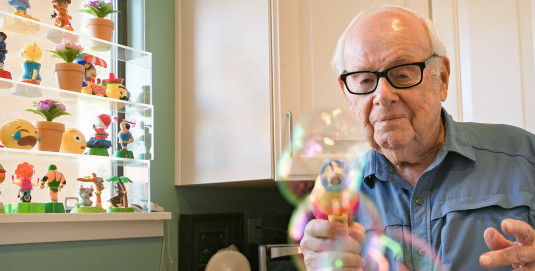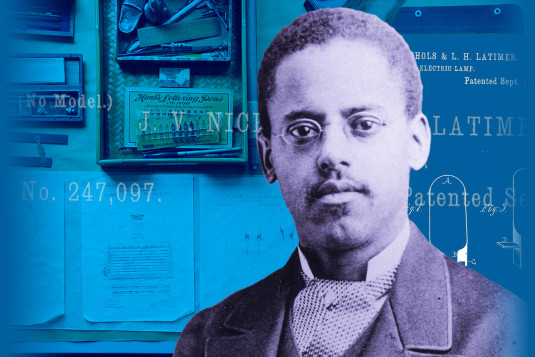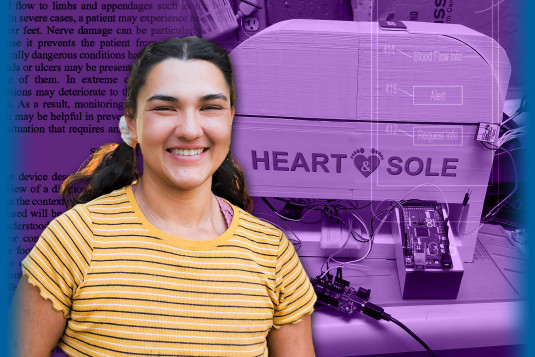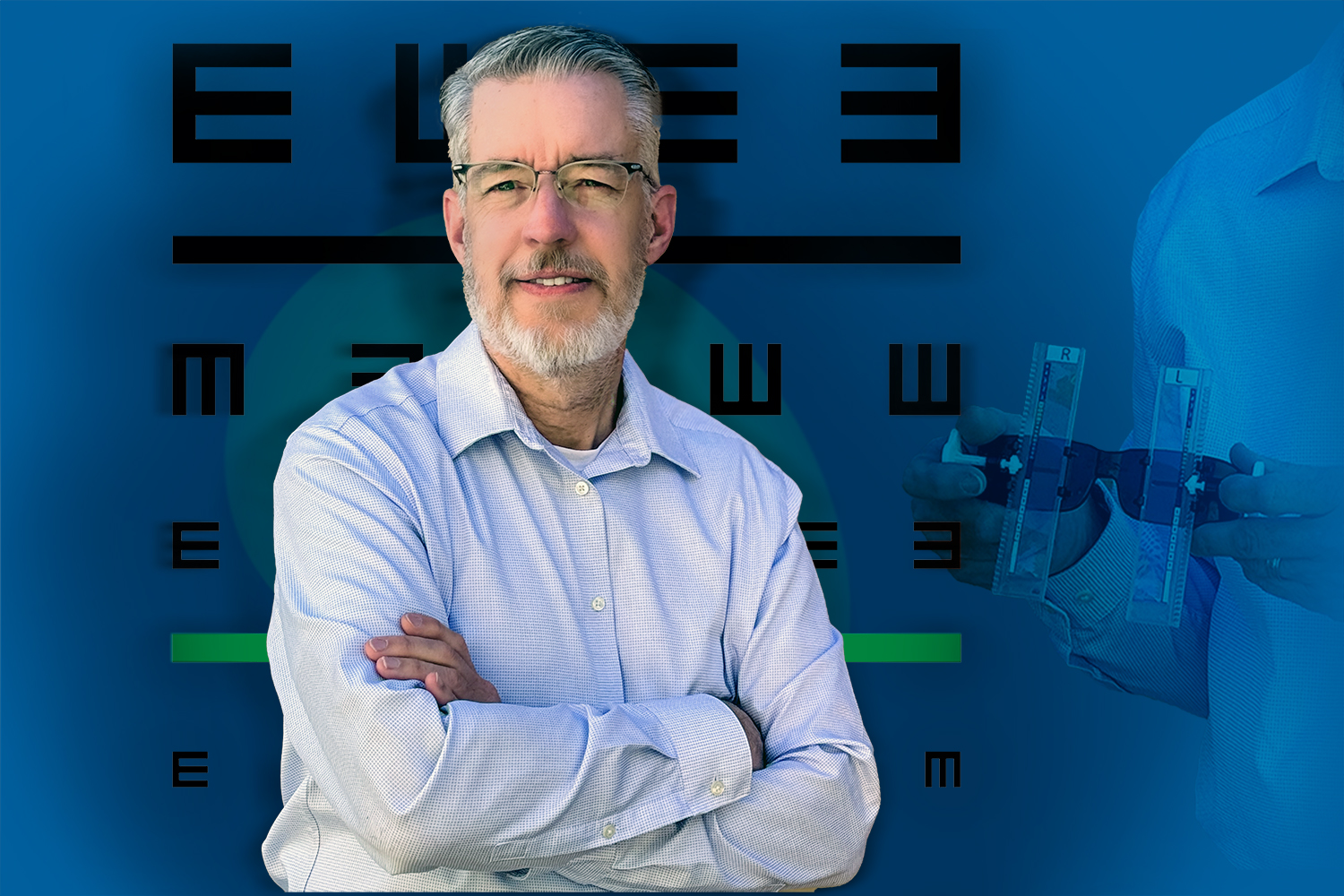
Serendipity-sharpened focus
A series of serendipitous events over a 20-year period helped J. Kevin White go from vision sufferer, to patented inventor, to becoming a global eye health advocate. He is working to bring practical solutions to communities that lack basic eye health care through his patented vision testing system and his Global Vision 2020 organization.
23 min read
Each month, our Journeys of Innovation series tells the stories of inventors or entrepreneurs who have made a positive difference in the world. This month, Whitney Pandil-Eaton's story focuses on J. Kevin White, a military veteran and inventor, who is bringing into focus an issue near and dear to him: correcting vision. For other stories about military veteran inventors, check out Inventors who serve.
Do you know an innovator or entrepreneur with an interesting story?

A caravan of three white 4x4 trucks saddled to the brim with water canteens, tents, solar batteries, food, and other essential supplies cuts through the arid and desolate Kunene region of northern Namibia. Home to lions, leopards, mountain zebras, giraffes, desert elephants, and black rhinos, the land has few roads to connect the scattered villages and homes of the indigenous semi-nomadic Himba people that reside in one of the last “true wildernesses” in southern Africa.
Traveling along a narrow and rocky road sprinkled with Baobab trees — known as the “tree of life” for their cultural and spiritual significance — the caravan is heading to one such remote village, Warmquelle, a small settlement situated on a spring near the Khowarib River. A mix of local guides, non-governmental organizations, and researchers, the group has come to the area to provide residents a critical and unmet need: eye health care. One among them, Kevin White, came to test out the diagnostic equipment and kit the former Marine had spent more than a decade perfecting.
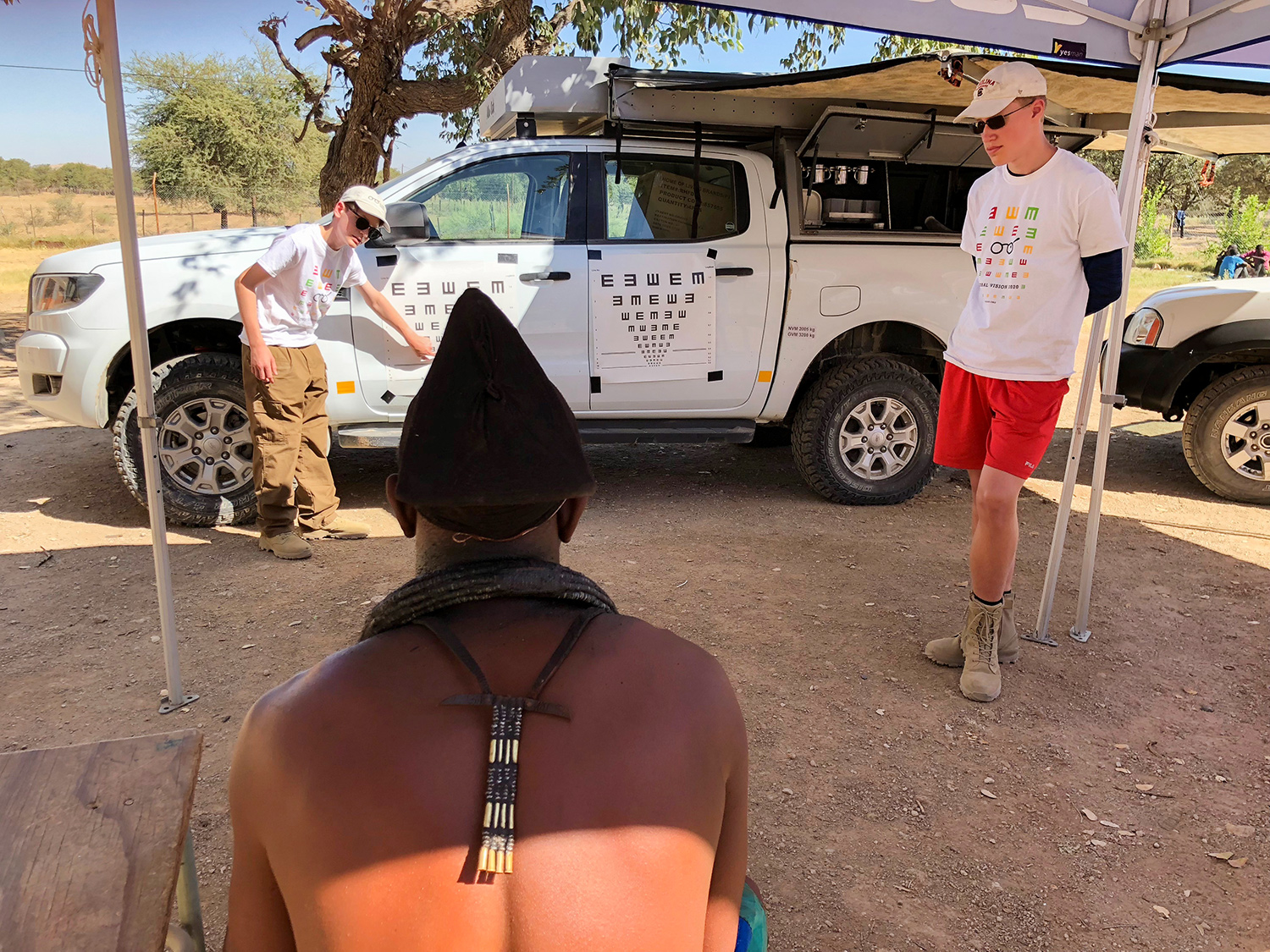
Oliver White, then 13 years old, conducts a vision test on a member of the Himba tribe, while his older brother Owen watches on. The two teenagers accompanied their father, Kevin, on the trip to Namibia to test his invention.
(Courtesy of Global Vision 2020)
Accompanied by his wife, Rebecca, and two teenage sons, White traveled some 7,000 miles by plane from Maryland to Namibia and then drove hours more through the rugged, baked Namib desert to ask a simple question:
“What do you see?”
Standing at the base of the nearly 1,000-foot-tall hill that defined his small village, a 13-year-old boy answered through a translator that he could see the hill, but not much else.
Handing the young man a pair of prescription glasses, its strength determined using White’s invention only 15 minutes prior under a pop-up tent built next to his school, White again repeated the question.
Putting on the thin-framed glasses, the boy’s eyes widened immediately as he scanned his surroundings and the hill above — before ripping them off and throwing them on a nearby table.
Anton Poplett, founder of the African-based humanitarian organization 4x4 Outfar who helped coordinate the trip, recalled the teenager’s reaction.
“He goes ‘No, it’s not right,’” Poplett said. “He looked up [the hill] every day, walking from the village to the school and he hadn’t seen anything [he was now seeing] … it was disbelief.”
Gently coaxed by Poplett and White to try again, the boy affixes the blue-framed glasses to his face and surveys his village.
“His mouth dropped,” White said. “He goes, ‘I can see that bush. I can see that rock. I can see that tree. I can see that goat. I can see my friend.’ And he goes up and up and up [the hill], and he's just pointing everything out. And at the top of the hill were two trees. And he starts screaming, I mean, screaming and jumping up and down. ‘I can see the two trees! I can see the two trees!’”
Standing nearby, the school principal explained to the men that while the village had an official name, it was never used, with locals opting to say they were from “the village with two trees.”
"That was [the boy's] entire geographic identity. And he'd never seen them before," White said, reflecting on that emotional day from 2018.
Athletically built with short brown hair, Poplett, a South African native and self-described “tough guy” who “puts his meat right on the coals,” couldn’t contain his emotions after witnessing the young man’s life-changing revelation.
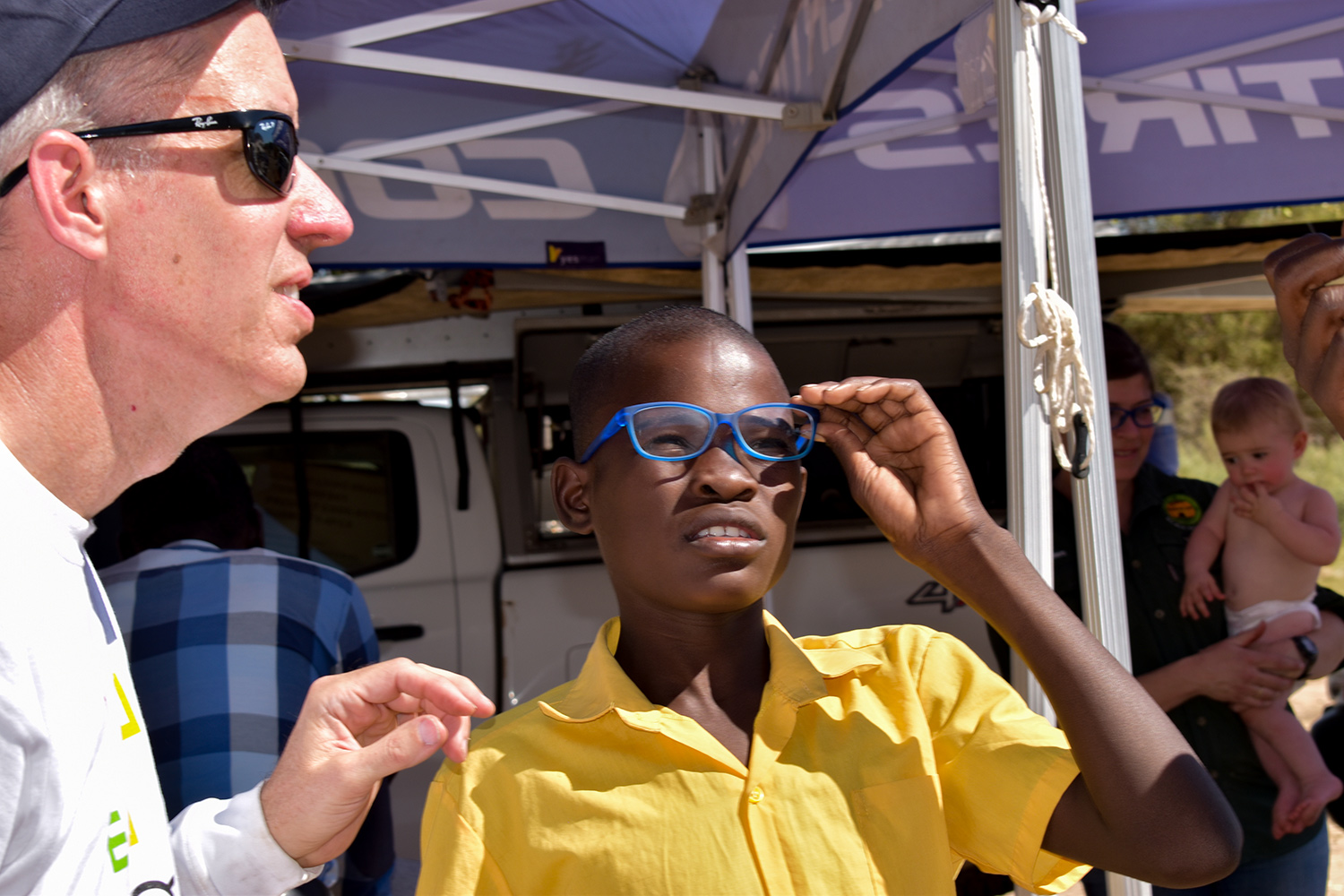
Kevin White, left, helps a 13-year-old boy from Namibia adjust to his new prescription eyeglasses. The young man was able to move up two grade levels after receiving the eyeglasses.
(Courtesy of Global Vision 2020)
“I walked around the corner of the vehicle and just cried, just let it absorb me,” he said, the emotions visibly raw years later. “I wiped my eyes, went back around the corner and I just put my arm around [him]. I said… ‘What you’re seeing is a hundred percent what you should be seeing’ and [I’m just] trying to hold it together myself.”
That teenager, who was on the verge of getting kicked out of school after being held in the second grade for years due to failing grades, moved up two grade levels within six months of receiving the eyeglasses.
Although this story has a happy ending, many others do not.
Globally, more than 2 billion people suffer from refractive error, often known as near or distance vision impairment, according to 2023 data from the World Health Organization (WHO). Of that total, the United Nations agency notes that more than half of cases could have been prevented.
It is the world’s largest unmet disability.
This is a fact that White, a military veteran and eyeglasses wearer since age 7, cannot abide.
“Find out what motivates you and what injustice do you not want to live with. This is mine. Eyeglasses is my injustice.”
Vision problems impact every aspect of life from education to employment, even basic safety, White said, noting that vehicle accidents are the number one killer of kids in Africa. But access to eye health care and eyeglass affordability continue to be barriers in many areas of the world.
In Western Europe, there is one optometrist for every 3,877 people, but that ratio jumps to a staggering 1:1.2 million in central sub-Saharan Africa, according to a 2023 study that looked at the global optometry workforce.
With a recommended ratio of 1:50,000, those who live in areas that exceed that threshold face real-life consequences at every stage of life.
For children, WHO observed that many with vision impairment “experience lower levels of educational achievement” while adults face “lower rates of employment and higher rates of depression and anxiety.” For the elderly, vision issues can contribute to increased physical safety concerns and social isolation. In total, researchers estimate annual productivity losses of $411 billion globally due to vision problems.
Touching his own pair of eyeglasses in reflection, White said, "I couldn't do what I've done. I couldn't have gone to the Naval Academy. I couldn't have done all of these things [without eyeglasses]... I thought about the moms and dads and kids with vision problems... I couldn't live with it."
Through a series of serendipitous events in his personal and professional life over a 20-year period, White has gone from vision sufferer to patented inventor and is now a global eye health advocate who is working to bring practical solutions to communities that lack basic eye health care through his patented USee Vision Kit and his Global Vision 2020 organization.
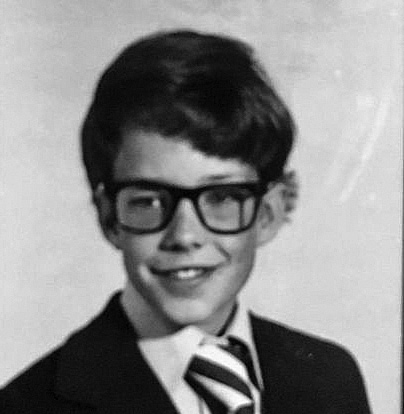
Kevin White sporting his “Elvis Costello specials” for a school photographer.
(Courtesy of Kevin White)
The son of an active-duty United States Air Force Russian linguist, J. Kevin White was born May 11, 1967, at an on-base U.S. military hospital in Ankara, Turkey. Typical of active-duty military service, the family moved just months later to England where White spent his childhood. Growing up, the American with a “Northampton British accent” enjoyed school and playing football (or soccer) in the English countryside — but it wasn’t all tea and crumpets.
At an early age, White noticed he had difficulty seeing the chalkboard in the classroom and could not see the ball if it was on the other side of the pitch. After a series of run-ins with walls at home, the then 7-year-old’s mother took him in to have his eyes checked — they were 20/50 — and he was fitted with a free pair of “Elvis Costello specials” courtesy of the country’s national health service.
“You put the glasses on and you’re like, 'Oh, this is what the world’s supposed to look like,'” he said, adding the change was profound but, as a youngster, was “quickly taken for granted.”
Although his first experience with eyeglasses was not as transformative as the boy in Namibia, White said his ability to see fine detail aided his schooling and proficiency in sports while also unlocking his joy for model building and tinkering with everyday items — interests that would serve him well in the future.
After nearly a decade and a half of living abroad, the family moved to the U.S. in 1980. Starting high school the following year, the teenager's acclimation to American culture was expedited due to his time at Osceola High School in Pinellas County.
With the movie “Animal House” as his only reference point to American college life, White’s British stepfather — his parents divorced when he was 3 years old — encouraged the young man to look at alternative options, with the then 18-year-old ultimately deciding to enlist in the U.S. Navy in 1985. White spent three years working as a machinist mate on the fast attack submarine USS Swordfish, learning about fluid dynamics, pressure testing, and engineering fundamentals before he applied to and was accepted to the Naval Academy, where he graduated in the class of 1992 and accepted his commission as a second lieutenant.
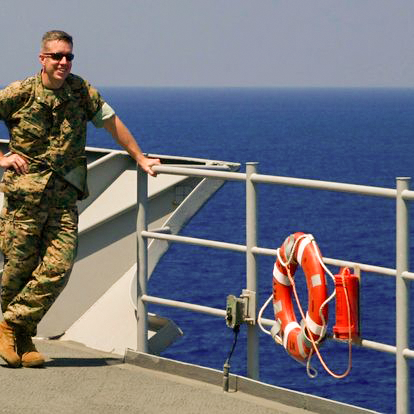
Kevin White spent three years in the Navy before he transitioned to the Marine Corps, where he spent the rest of his military career.
(Courtesy of Kevin White)
Having spent time under the water learning principles that would later be key to crafting his invention, White took the opportunity to make an impact on land by joining the Marine Corps.
“It really appealed to me that when the balloon goes up for war, they’re… always the first to fight,” he said. “[The Marine Corps] had a mission that I really wanted to sink my teeth into.”
A problem-solver at heart with a penchant for math, the young officer gravitated toward logistics, which involves the coordinated large-scale movement of personnel, equipment, fuel, ammunition, medical, and food supplies.
“It’s making sure that you have what you need to continue to fight, and sometimes that can be creative and sometimes it’s just pedantic tables,” he said. “It was complicated, but I enjoyed getting things done and getting things solved.”
The Marine officer spent the next decade honing his leadership, logistics, and problem-solving skills during various duty assignments. In 2003, those skills were put into real-world action when White deployed to Iraq as part of Operation Iraqi Freedom, serving as alpha company commander for the Second Transportation Support Battalion, which coordinated supply convoys between Kuwait and Baghdad.
The knowledge he gained from his time in the Navy, the years of logistics training, and his experiences on deployment would coalesce in an unforeseen way when White went to U.S. European Command to serve as a humanitarian assistance officer, in charge of coordinating and operating humanitarian assistance programs throughout Africa.
In January 2005, in his first mission in that role, White helped coordinate the building of a five-room school and a field hospital in rural Morocco. In addition to doing cleft palate surgeries and dental work, the group also conducted vision testing and handed out pairs of donated prescription eyeglasses.
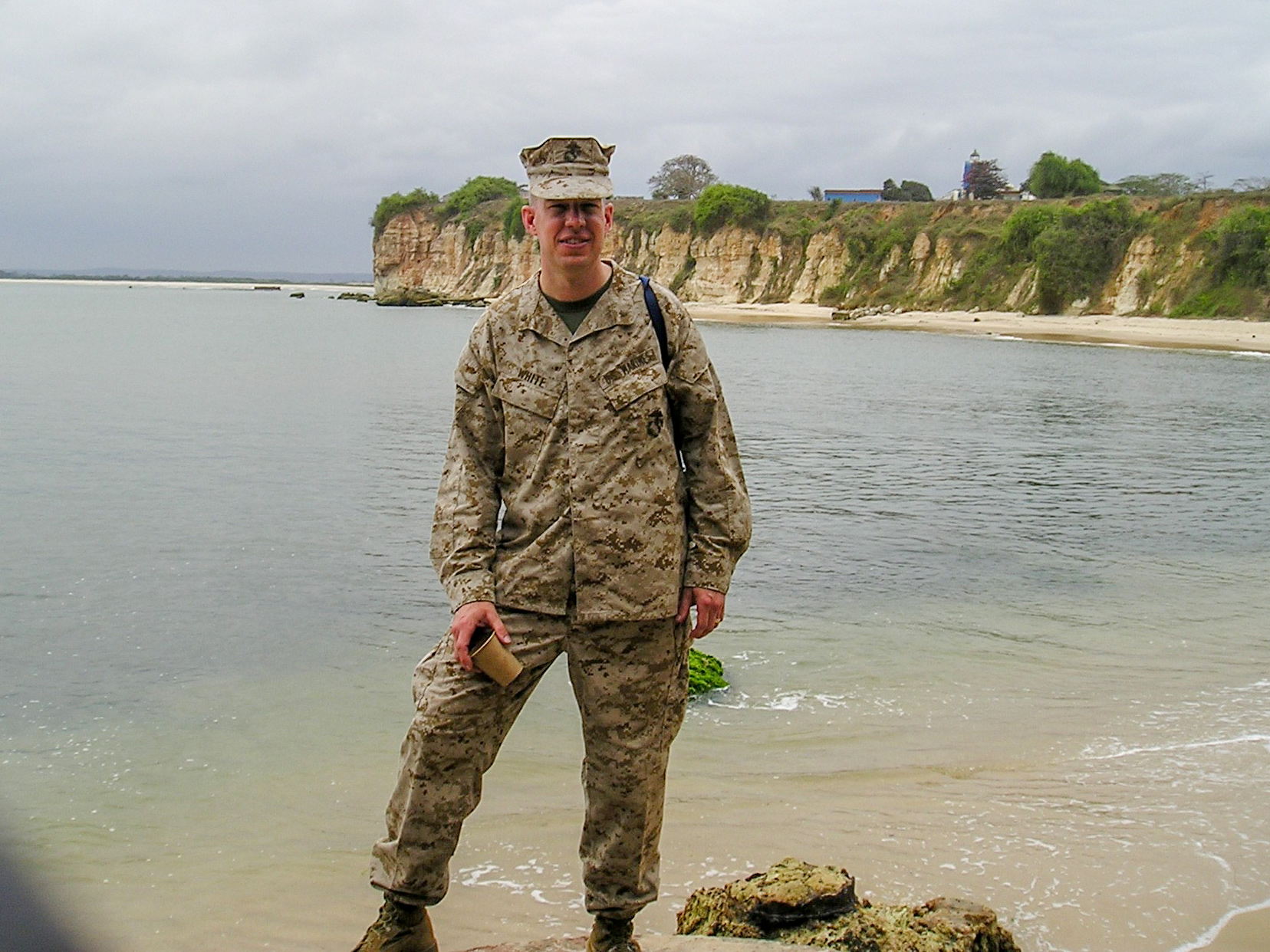
As a humanitarian assistance officer with U.S. European Command, White was tasked with coordinating relief efforts between military units and local communities throughout Africa.
(Courtesy of Kevin White)
At that time, medical personnel used an auto refractor, which uses a laser to measure the refraction of the eye, to determine, often inaccurately, a prescription strength for eyeglasses. Typically, an optometrist will use that preliminary information and conduct further subjective testing to get a more accurate diagnosis, but that technology and expertise was not then available.
White said he witnessed an interaction that challenged his preconceived ideas about eye health and set him on the path to inventorship and advocacy.
“There’s this young woman in her Saturday best,” he said. After administering a vision test and determining the required prescription power, medical professionals selected a pair of glasses and handed them to her. “She put them on, and she could see, OK, not great… but they were 1985 Farrah Fawcett, massive rose-colored glasses with a gradient rose-colored tint all the way down it. And she's, like, handing them back, waving her finger, [saying] ‘I'm not wearing these.’”
After a gesture-filled back and forth between the woman and medical personnel, White said she picked up a pair of thin-framed eyeglasses that were not her prescription.
“She put them on her face, couldn’t see anything, moved them down to the end of her nose and walked out,” he said.
It was then, White said, that he learned that aesthetics is an equally important aspect of eye health that has to be addressed in concert with finding an accurate prescription.
"It doesn't matter [your economic or social circumstances], nobody wants to look stupid. And I said, 'Man, there has got to be a better way.' So, I left Morocco determined to find out more about the problem."
Still an active-duty Marine, White spent the next four years learning more about general eye health, the eyeglass industry and technology, the access and cost disparities that existed globally, and making connections to others researching the topic until he retired from the military in 2009.
White’s research led him to Joshua Silver, a physicist at Oxford University, who invented low-cost and self-adjustable fluid-filled lenses for rural and low-income communities. From 2009 to 2013, the duo teamed up to conduct research and ship 30,000 pairs of eyeglasses, called Adspecs, to communities across Africa but ran into familiar resistance.
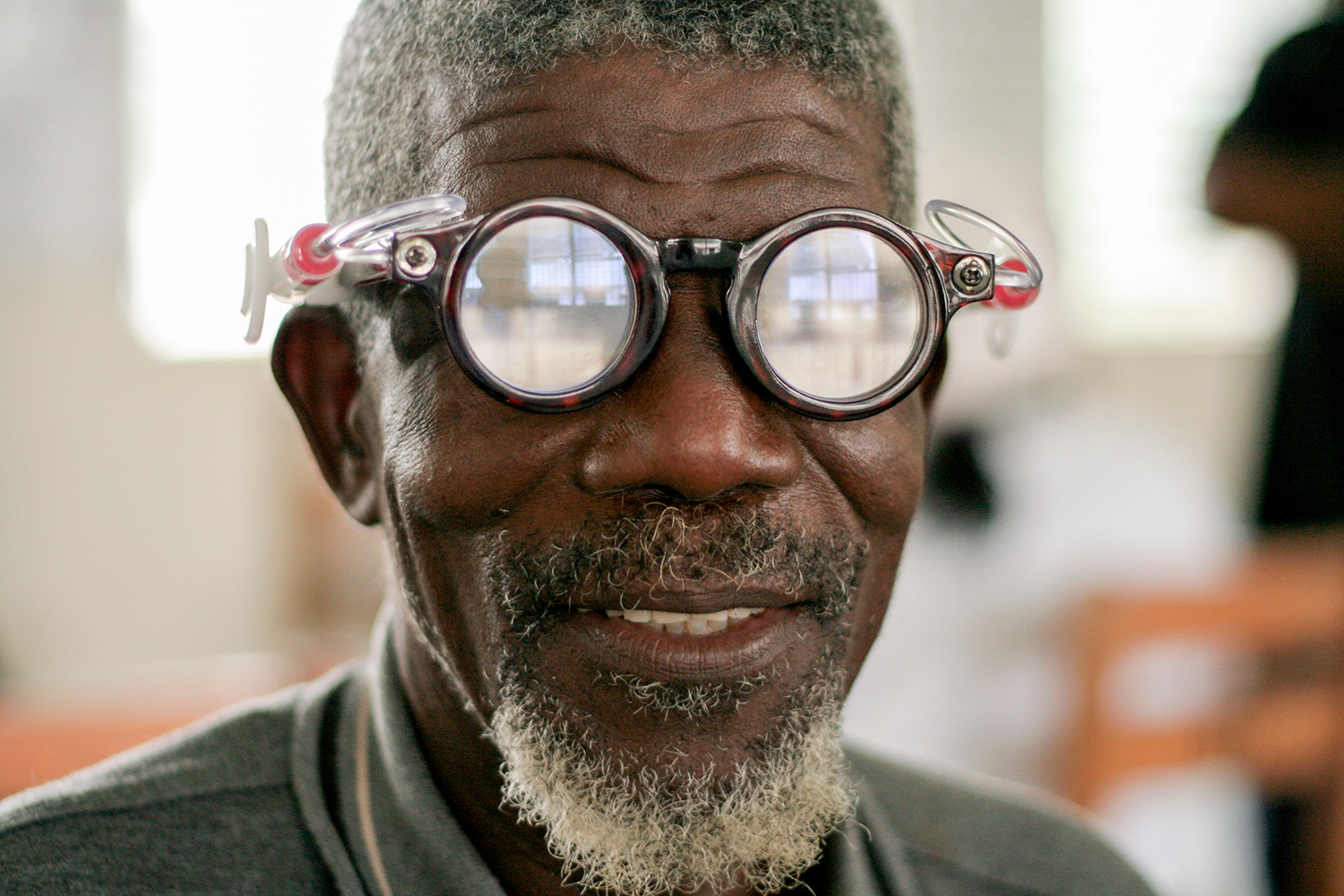
An elderly man wearing a pair of Adspecs glasses.
(Courtesy of Global Vision 2020)
Designed with a syringe and dial that could increase or decrease the pressure between the layers of lenses, thus changing the power of the lens, the eyeglasses were functional, but not aesthetically pleasing.
“I had the same issue with these as that young lady had with her 1985 pair of Fawcett glasses,” White said. “I could get 65-year-old men to wear them. I could not get 25-year-old men to wear them, and young women were just like ‘No, I’m not wearing those.’”
Using his knowledge of fluid dynamics honed during his Navy days, White identified problems with the Adspecs glasses during the research process when trying to use them as a field refraction/vision testing device.
With fluids, “you have to calibrate it. And if you have a leak or if the pressure changes or temperature changes or all these things, it would be out of calibration,” he said. “So even though this worked for the patient to dial in, you would never get a 100% accurate prescription on any given day.”
Despite the drawbacks associated with the fluid-filled glasses, the ability for people to self-dial in their prescription was validated by scientific studies — a breakthrough finding that can reduce barriers to eye health care access in developing countries.
With one piece of the puzzle solved, White devoted his full attention to finding a solution to the lens problem and developing an accurate, sustainable, portable vision diagnostic system and an aesthetically pleasing eyeglasses kit.
Using the Adspecs for inspiration, White spent months in the pencil and paper ideation process before connecting with David Crosby at Oxford University who agreed to make a half lens that would range from negative six to positive six, denoted by tick marks.
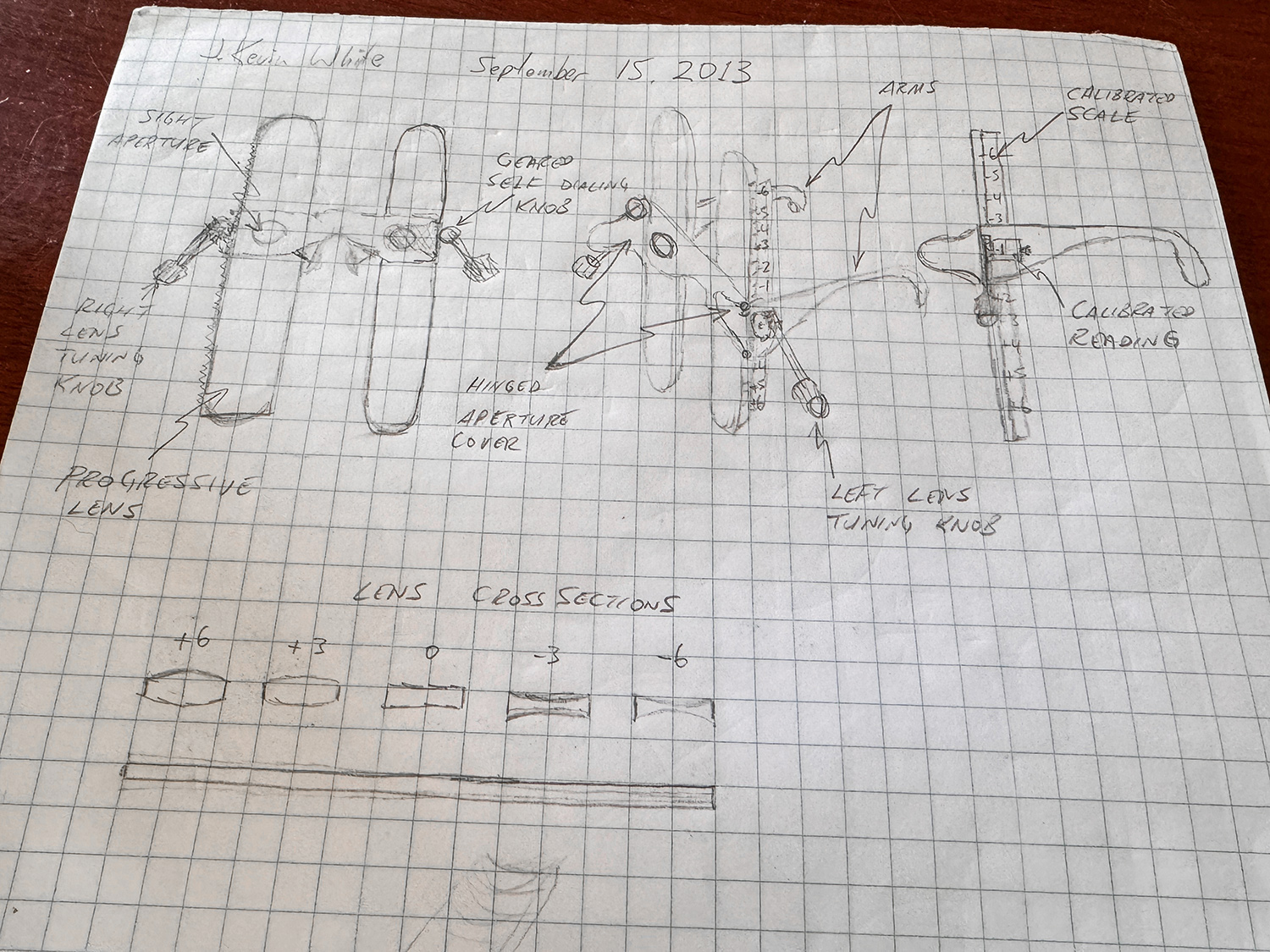
Kevin White’s pencil sketch for his invention, a vision testing apparatus that allows patients to self-dial in their prescription. It would take nearly a decade for White’s invention to go from pencil and paper to a patented device.
(Courtesy of Kevin White)
The prototype arrived at White’s house in Easton, Maryland, mere days after his then 10-year-old son, Oliver, had received his updated eyeglass prescription from his optometrist — a serendipitous occurrence.
Making a slit in an index card, White asked his son to test his diagnostic lens by looking through the index card and moving the variable power lens until he could see clearly.
“He’s just moving the lens up and down and he goes ‘Right there, Dad.’ So, I pinched the card together and counted the tick marks and it was minus one and a half,” he said. “And [then] I turn the prescription over and it was minus one and a half. I said, ‘Man, this works… that’s when I knew I was onto something.”
With the lens verified, White next went to work on the frames, sending out a Facebook message asking if any of his connections had a 3D printer. In yet another serendipitous turn of events, his message was answered by an acquaintance he had met years ago while learning about the eye health industry. This acquaintance, who had recently joined plastics manufacturer PolyOne, reached out to White to offer assistance.
For the next four years, White’s invention would go through the research and design process, clinical trials, and in-the-field testing in several countries across the world.
“What I learned from that whole process is that one person can draw it, but you need like six or seven specialists to make it a reality,” he said. “It took a team.”
Part of that team included experts at PolyOne, now called Avient Corporation, who worked with the inventor for about two years to produce the diagnostic device.
Due to the technical and economic considerations of the device, the most difficult aspect of the design was developing the injection molded polycarbonate eyeglasses frames, said Jane Spikowski, innovation team lead on the project. To account for the varying curvature and thickness requirements, she said the team used mold-flow simulation software in order to fine tune the product and produce accurate black frames consistently that would integrate seamlessly with the other device’s features.
“I would rate the difficulty as high,” added Brian Everett, global design director at Avient, who also worked on the project. “This product had to work for any age of person, any size of person... from an ergonomic perspective, it’s pretty challenging to make a product to accommodate any unknown variables.”
When issues arose, White was quick to bring in outside experts to address them.
“[He] did such a good job of bringing together a multidisciplinary team of people who were experts so that we could solve those problems together,” Spikowski said.
“To hear the passion he had for this idea and to trust us to bring it to life... it’s one of our favorite projects of all time,” Everett added.
When it came to the patent process, White leaned into his military connections. An Academy classmate introduced the inventor to patent attorney Melissa Coombes, a veteran and Naval Academy alum who agreed to take on the prosecution pro bono.
After more than a decade of work, White’s pencil-sketch-turned-prototype was transformed into U.S. Patent No. 11,395,587, granted July 26, 2022.
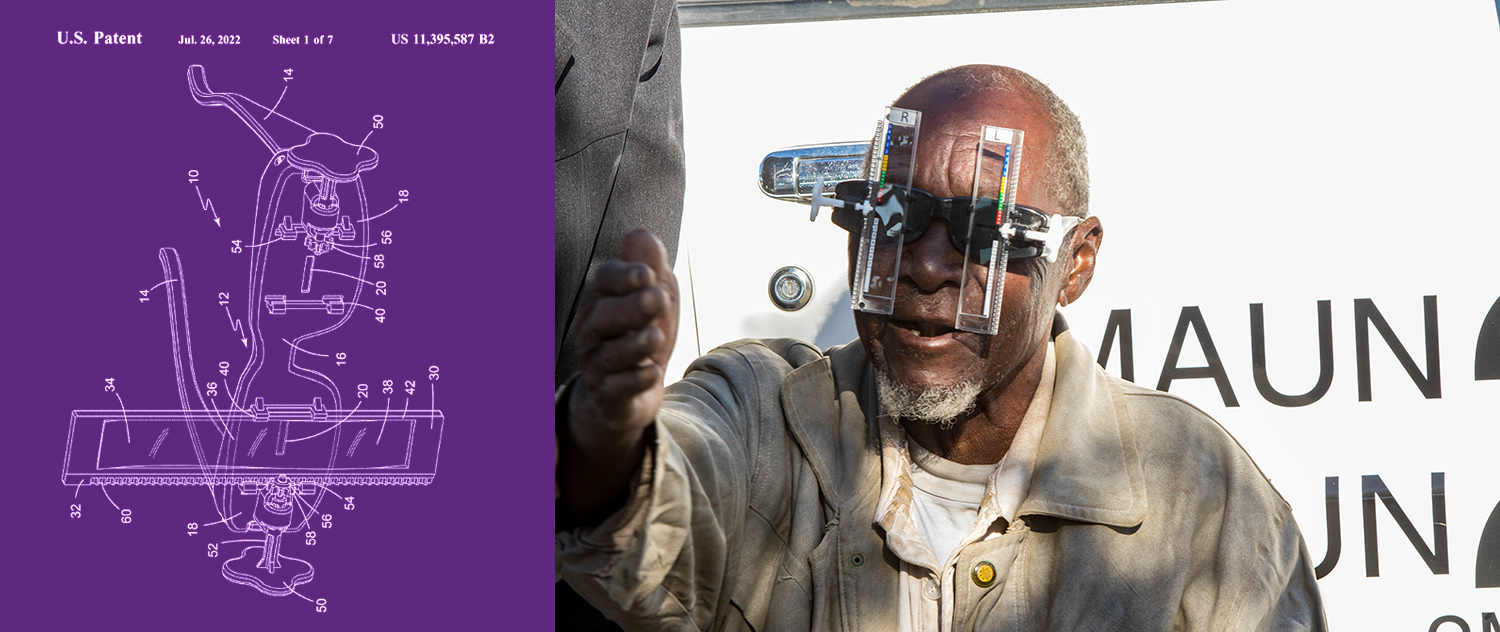
A man is having his vision tested using inventor Kevin White’s USee vision testing apparatus in Botswana.
(Courtesy of Global Vision 2020)
If a person is determined to have vision problems — identified through a standard eye test — the next step is White’s invention.
Similar to using a pair of binoculars, to use the USee vision testing apparatus the person wearing the diagnostic glasses would turn the dial located on the frame to slide the variable power lens up or down — thus increasing or decreasing the power — until the person naturally finds the correct power of lens needed.
The vision testing apparatus is part of Global Vision 2020’s USee Vision Kit, which includes 250 frames in 3 colors, 540 snap-in lenses in various powers, ready-made reading glasses with different powers and colors, and other diagnostic accessories.
As a business-to-business nonprofit, Global Vision 2020 sells the kits to non-governmental organizations, health groups, and government agencies, and provides logistics services, eye health training, and resources via the organization’s app. To date, more than 750,000 people in 67 nations have benefitted from White’s invention and eye health care advocacy.
With researchers projecting the number of people with vision impairment to balloon to 5 billion by 2050, White said this “healthcare teamwork” approach is vital, especially in places such as the Democratic Republic of Congo (DRC), which has a handful of optometrists to treat the nation’s 100 million citizens.
Recently, an organization was using White’s USee Vision Kit to test lawyers at the DRC’s Ministry of Justice, when one of them asked for the team to travel to their teenage children’s school to test some of students.
It was a school for the blind.
“They screened 50 kids. Eighteen of them walked out of the school [for the blind] and walked across the street to the school for the sighted because they just needed eyeglasses. Why are we OK with this?”
While the invention is beneficial to an individual, White points to the cascading effect corrected vision can have on a family.
During a recent trip to Rwanda, a granddaughter brought her 83-year-old widowed grandmother into the clinic to have her vision tested. Unable to see clearly for the last three decades, the grandmother relied heavily on her family to perform daily activities. After the initial vision test, the elderly woman was given a pair of prescription glasses and asked to read by a local nurse.
“She gets the first line out, and then stops. So, we lean in and she’s just sobbing,” White said. “She [hadn’t] been able to read in 30 years.”
In addition to reading glasses, the grandmother was also outfitted with distance glasses which allowed her to navigate her surroundings independently and provide her children and grandchildren with an oral history of their family’s time in the village.
As part of routine follow-up, a local caregiver checked in on the grandmother and her family a few weeks later.
"When he showed up, she was reading to the young kids. All the older kids were either at school or in the fields working. She was repairing clothing; she was fixing meals. She became the matriarch of the family for $10 worth of eyeglasses."
Although White’s USee Vision Kit is used primarily overseas in developing countries, his invention is making a difference in the United States to address health care gaps for marginalized groups.
In Arizona, university students in the medical and social science fields are using the kits to provide vision testing and prescription eyeglasses to the unsheltered persons in the Phoenix area. The efforts are part of Street Medicine Phoenix (SMP), a “student-driven interprofessional health care and social justice team” that provides a “biopsychosocial, trauma-informed model of care” for the city’s homeless population under the direction of faculty members at universities in-state and across the country. In Maricopa County, where Phoenix is located, the homeless population exceeds 10,000.
Catherine Miller, SMP program lead, said due to a variety of factors, most of the patients are only seen once, which can complicate health care that requires follow-up. The USee Vision Kit solves that problem.
“This device allows us to do everything at once, a one-stop shop,” she said. “Everyone has been blown away by it.”
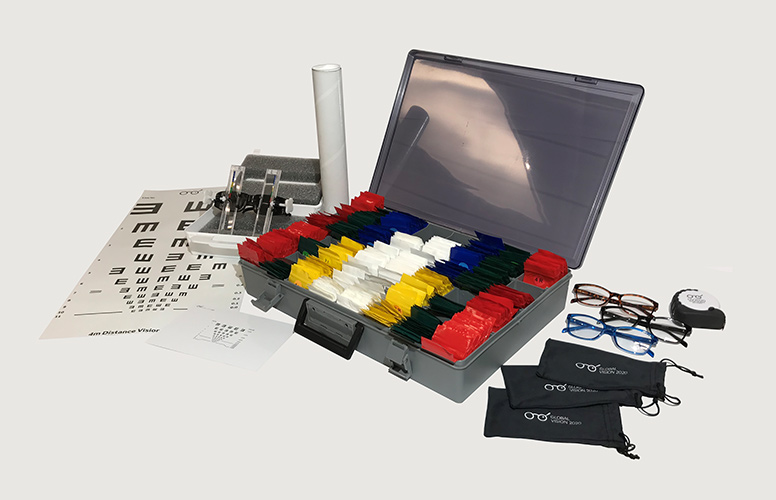
Developed by inventor Kevin White, the USee Vision Kit includes a vision testing apparatus, color-coded power lenses, eyeglass frames in a variety of colors, reading glasses, and other accessories. The kit is making a difference in the United States and other countries to address eye health care gaps for marginalized groups.
(Courtesy of Kevin White)
Miller points to one recent success story. A gentleman living on the streets was screened by SMP volunteers and was given a pair of prescription eyeglasses.
“He came back weeks later and told us he was able to apply for a CDL license test and was applying for jobs,” she said. “This has the potential to allow people to escape homelessness.”
Over the last four months, Miller said volunteers have used the USee device to provide vision tests to 100 people. Overall, using White's kit and other vision diagnostic tools and products, the SMP optometry team has provided nearly 400 pairs of prescription and reading eyeglasses to homeless individuals in the area since January 2022.
For his global efforts and advocacy, White has received numerous awards including National Geographic’s Chasing Genius Award, a WeWork Creator award, gold in the Social Impact Design category from the Industrial Designers Society of America in 2019, who sponsor the International Design Excellence Awards, and Patents for Humanity, an award competition that recognizes innovators who use game-changing technology to meet global humanitarian challenges awarded by the United States Patent and Trademark Office.
While the financial awards associated with the various accolades have allowed him to further his humanitarian goals, those who have worked closely with White have seen that his passion, grit, and character have been the true tick marks of his laser-focused approach to success.
“Kevin is an outstanding guy,” Poplett said. “If Kevin said ‘Listen, I need something.’ I would do what I can. He’s never let me down. He’s always been upfront and honest and we’ve always had a good laugh, always.”
“One of the things that the military really imbues in you is service before self,” Coombes, a veteran helicopter pilot and intellectual property attorney, said. “[He] came up with this idea that is going to serve and help people… the focus on serving others I don’t think it ever leaves you, honestly. It becomes the foundation of who you are as an adult.”
Retired from the military but not his mission, White continues to push for increased access to eye health care for the roughly 65% of the globe that lacks adequate services.
He is working to identify government agencies, community healthcare groups, or other networks that could help distribute eyeglasses.
“Bill Gates solved polio,” the inventor said. “I would love to find a foundation or a billionaire that says, ‘You know what? I want to address the world’s largest unmet disability. I want to be the name associated with getting this 700-year-old invention to everybody on the planet that needs it so that all those kids have equal access to education, all those drivers have equal access to safe driving that we have in the United States and Europe and so on.”
For White, this is about more than solving a technical problem.
Alluding to technology’s ability to provide convenience:
“You can live a passive life at this point... but what does that do for your inner soul? What does that do for your community? What does that do for the economy?”
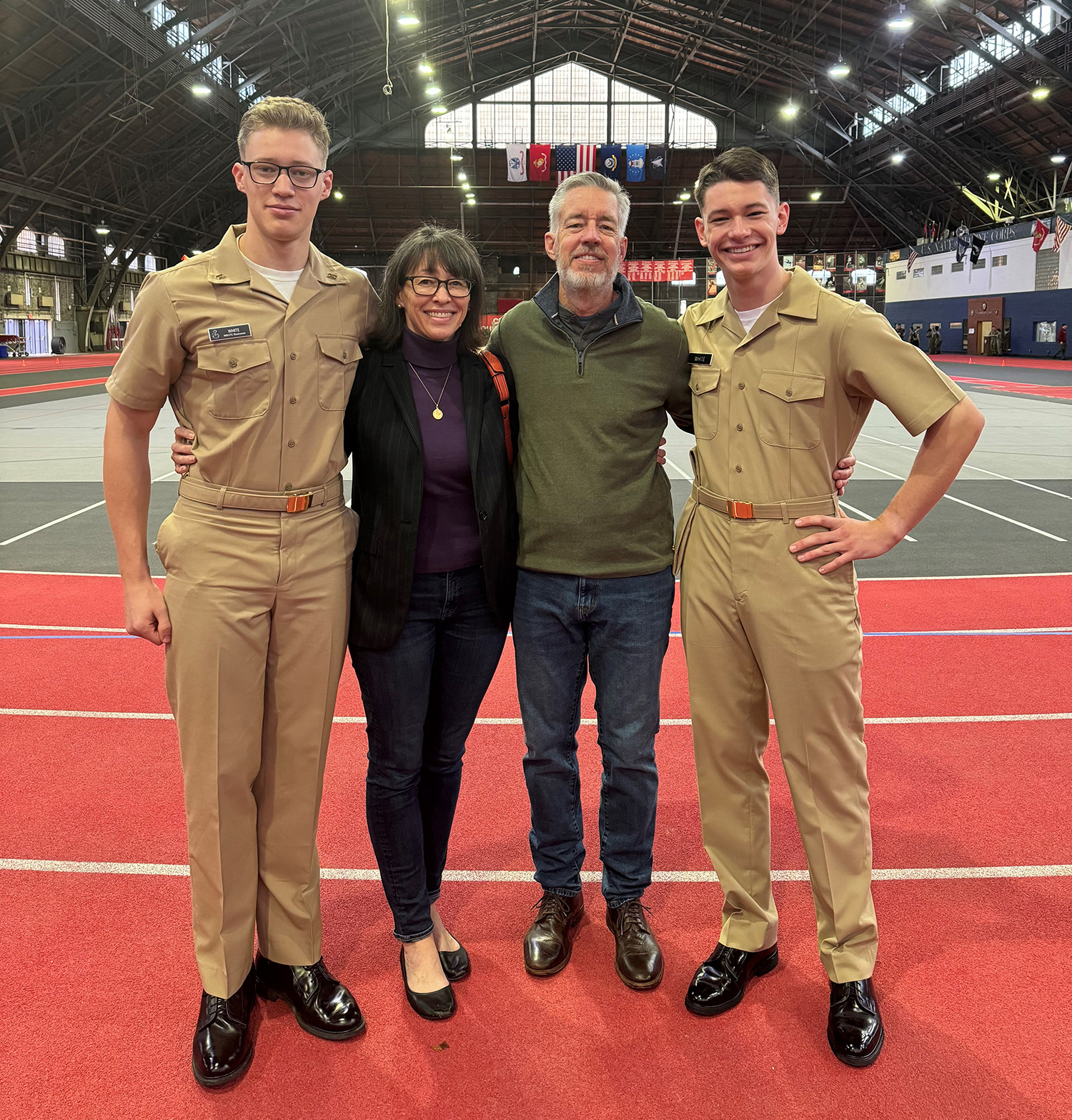
Owen White, left, with his mom, Rebecca Guay, father Kevin White, and younger brother Oliver White. Following in their father’s footsteps, both young men plan to join the military after college and are both currently enrolled in Naval Reserve Officers’ Training Corp programs.
(Courtesy of Kevin White)
He’s passed on his passion to the next generation, too.
Having traveled around the world in support of their father’s Global Vision 2020 mission, both Oliver and Owen have taken the service-before-self mentality both in their private lives and their future careers.
Although they were 5 and 7 years old when White retired from the military, both men are continuing the family tradition of military service. Oliver and Owen are both enrolled in Naval Reserve Officers’ Training Corp programs at their respective universities. As part of his college application process, Oliver wrote an essay detailing the lessons he learned from his time distributing eyeglasses from Peru to Namibia.
“Experiences like [that] are what taught me to allow myself to be more open minded than I ever had before. They have helped me become the person I am today,” he wrote in the 2022 essay. “I learned that my comfort zone can not only be left, but can be expanded. Every day, I pick something new to bring into my comfort zone, expanding my horizons.”
Whether it be through military service or community activism, White challenges people of all ages to identify a problem and set about solving it.
For the white-haired but fit veteran-inventor, his eyes are firmly focused on one thing: universal access to eye health care.
“My next step, my goal, is to solve that. Once we have ubiquitous eyeglass access then I’ll be happy,” he said. “It just seems fair. What’s not fair is being born in a place that doesn’t have access and having to suffer because of it.”
Credits
Produced by the USPTO’s Office of the Chief Communications Officer. For feedback or questions, please contact inventorstories@uspto.gov.
Story by Whitney Pandil-Eaton. Graphic by Gabriella McNevin-Melendez. Additional contributions from Linda Hosler, Christy Whitaker, and Jon Abboud. Special thanks to Kevin White, Anton Poplett, Catherine Miller, Melissa Coombes, Jane Spikowski, and Brian Everett.
The photo of the 4x4 truck in Namibia at the beginning of the story is courtesy of Global Vision 2020.
References
4x4 Outfar. “Namibia.” https://4x4outfar.com/projects/namibia/
4x4 Outfar. “Eye testing humanitarian foundation in Africa.” 2022. https://www.youtube.com/watch?v=w3SmQwhiaWc
4x4 Outfar. “Very good’s- 4x4 out far.” https://www.youtube.com/watch?v=Hohxec-Jleo
Annadanam A, Varadaraj V, Mudie LI, Liu A, Plum WG, et al. (2018) Comparison of self-refraction using a simple device, USee, with manifest refraction in adults. PLOS ONE 13(2): e0192055. https://doi.org/10.1371/journal.pone.0192055
Avient. “PolyOne Helps Global Vision 2020 Bring the USee to life.” April 8, 2019. https://www.avient.com/news/polyone-helps-global-vision-2020-bring-usee-life
Blindness and vision impairment. World Health Organization. August 10, 2023. https://www.who.int/news-room/fact-sheets/detail/blindness-and-visual-impairment
Blog Post. Easton Economic Development Corporation. https://eastonedc.com/2022/09/for-your-eyes-only-interview-with-kevin-white-founder-of-global-vision-2020/
Coombes, Melissa. Interview by Whitney Pandil-Eaton. October 11, 2024.
Connolly, Connie. “Kevin White’s USee system wins gold.” The Star Democrat. September 18, 2019. https://www.stardem.com/news/local_news/kevin-whites-usee-system-wins-gold/article_51f13758-16bb-5162-865c-619159fb6f81.html
Global Vision 2020. https://gv2020.org/
Google Earth. Warmquelle, Namibia. Accessed October 2, 2024.
Google Maps. C43 Namibia. Accessed October 2, 2024.
Maun 2 Maun. Explore 4 Knowledge. https://www.explore4knowledge.com/maun-2-maun/
Maun 2 Maun Expedition Overview Part 1. Explore 4 Knowledge. https://youtu.be/AiXZa4Tj3q8
Maun 2 Maun Expedition Overview Part 2. Explore 4 Knowledge. https://youtu.be/Im-K0iBXaP4
Miller, Catherine. Interview by Whitney Pandil-Eaton. October 10, 2024.
Naidoo KS, Govender-Poonsamy P., Morjaria P, et al. Global mapping of optometry workforce. Africa Vision Eye Health, 2023. 82(1), a850. https://doi.org/10.4102/aveh.v82i1.850
Namibia Travel Guide. http://www.namibia-travel-guide.com/bradt_guide.asp?bradt=832
Petruzzello, M.. "baobab." Encyclopedia Britannica, October 4, 2024. https://www.britannica.com/plant/baobab-tree-genus.
Poplett, Anton. Interview by Whitney Pandil-Eaton. October 8, 2024.
Ramsay, Scott. “Photo story: a portrait of Namibia’s Kunene region, home to desert wildlife and star-studded skies.” October 27, 2022. https://www.nationalgeographic.com/travel/article/photo-story-namibia-kunene-region-wildlife-stars
Street Medicine Phoenix. The University of Arizona Mel & Enid Zuckerman College of Public Health. https://publichealth.arizona.edu/outreach/street-medicine-phoenix
White, Kevin. Interview by Whitney Pandil-Eaton. July 15, 2024.
White, Kevin. Interview by Whitney Pandil-Eaton. July 30, 2024.
White, Kevin. Interview by Whitney Pandil-Eaton. October 10, 2024.


